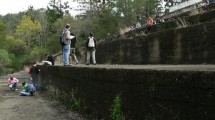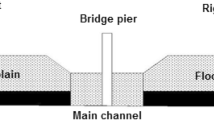Abstract
The leading cause of bridge failure has often been identified as bridge scour, which is generally defined as the erosion or removal of streambed and/or bank material around bridge foundations due to flowing water. These scour critical bridges are particularly vulnerable during extreme flood events, and pose a major risk to human life, transportation infrastructure, and economic sustainability. Retrofitting the thousands of undersized and scour critical bridges to more rigorous standards is prohibitively expensive requiring effective yet economical countermeasures. This research tested the efficacy of using approach embankments as intentional sacrificial “fuses” to protect the bridge integrity and minimize damage during large flow events by allowing the streams to access their natural floodplain and reduce channel velocities. This countermeasure concept was evaluated using the Hydrologic Engineering Center’s River Analysis System models. Steady flow models were developed for three specific bridges on two river reaches. Streamflow return period estimators for both river reaches were developed using Bayesian analysis and available United States Geological Survey stream gauge data to evaluate sacrificial embankments under non-stationary climatic conditions. The use of sacrificial embankments was determined to be a cost-effective scour mitigation strategy for bridges with suboptimal hydraulic capacity and unknown or shallow foundations. Additional benefits of sacrificial embankments include reductions in upstream flood stage and velocity.



Source: Vermont Agency of Transportation (2014)

Data source: Anderson et al. (2017)






Similar content being viewed by others
References
Anderson I, Rizzo DM, Huston DR, Dewoolkar MM (2017) Analysis of bridge and stream conditions of over 300 Vermont bridges damaged in tropical Storm Irene. Struct Infrastruct Eng. doi:10.1080/15732479.2017.1285329
Arneson LA, Zevenbergen LW, Lagasse PF, Clopper PE (2012) Evaluating scour at bridges, No. FHWA-HIF-12-003
Botto A, Ganora D, Laio F, Claps P (2014) Uncertainty compliant design flood estimation. Water Resour Res 50(5):4242–4253
Briaud L, Ting K, Chen C, Gudavalli R, Perugu S, Wei G (1999) SRICOS: prediction of scour rate in cohesive soils at bridge piers. J Geotech Geoenviron Eng 125(4):237246
Burrows S, Everett M (2015) Bridges and Structures. Additional guidance on 23 CFR 650 D. Federal Highway Administration. https://www.fhwa.dot.gov/bridge/0650dsup.cfm. Accessed 30 July 2016
FHWA (1973) A statistical summary of the cause and cost of bridge failures. Federal Highway Administration, U.S. Department of Transportation, Washington, DC (Chang FFM)
FHWA (1978) Countermeasures for hydraulic problems at bridges. vol 1 and 2, FHWA/RD-78-162&163, Federal Highway Administration, U.S. Department of Transportation, Washington, DC (Brice JC, Blodgett JC)
FHWA (2015) Recording and coding guide for the structure inventory and appraisal of the nation’s bridges. Federal Highway Administration Report No. FHWA-PD-96-01, U.S. Department of Transportation, Washington, DC
Fowler HJ, Ekstrom M, Kilsby CG, Jones PD (2005) New estimates of future changes in extreme rainfall across the UK using regional climate model integrations. 1. Assessment of control climate. J Hydrol 300:212–233
Fu G, Yu J, Yu X, Ouyang R, Zhang Y, Wang P, Liu W, Min L (2013) Temporal variation of extreme rainfall events in China, 1961–2009. J Hydrol 487:48–59
Guilbert J, Betts AK, Rizzo DM, Beckage B, Bomblies A (2015) Characterization of increased persistence and intensity of precipitation in the northeastern United States. Geophys Res Lett 42(6):1888–1893
Jaffe D, Sanders B (2001) Engineered levee breaches for flood mitigation. J Hydraul Eng 127(6):471–479. doi:10.1061/(ASCE)0733-9429(2001)
Karl TR, Gleason BE, Menne MJ, Mcmahon JR, Heim RR, Brewer MJ, Kunkel KE, Arndt DS, Privette JL, Bates JJ, Groisman PY, Easterling DR (2012) U.S. temperature and drought: recent anomalies and trends. Eos Trans AGU Eos Trans Am Geophys Union 93(47):473
Kattell J, Eriksson M (1998) Bridge scour evaluation: screening, analysis, and countermeasures. US Forest Service, Sam Dimas Technology and Development Center, Sam Dimas, CA
Laio F, Di Baldassaree G, Montanari A (2009) Model selection tehcniques for the frequency analysis of hydrological extremes. Water Resour Res 45:W07416. doi:10.1029/2007WR006666
Luke A, Kaplan B, Neal J, Lant J, Sanders B, Bates P, Alsdorf D (2015) Hydraulic modeling of the 2011 New Madrid floodway activation: a case study on floodway activation controls. Nat Hazards 77(3):1863–1887
Melville BW, Coleman SE (1973) Bridge scour. Water Resources Publications, LLC, Littleton
Pugh CA (1985) Hydraulic model studies of fuse-plug embankments, United States Bureau of Reclamation, Department of the Interior, Denver, CO: Hydraulics Branch, Division of Research and Laboratory Services, Engineering and Research Center, U.S. Department of the Interior, Bureau of Reclamation, REC-ERC-85-7
Rajeevan M, Bhate J, Jaswal AK (2008) Analysis of variability and trends of extreme rainfall events over India using 104 years of gridded daily rainfall data. Geophys Res Lett 35(18):1–6
Schmocker L, Höck E, Mayor P, Weitbrecht V (2013) Hydraulic model study of the fuse-plug spillway at Hagneck Canal, Switzerland. J Hydraul Eng 139(8):894–904
Schmocker-Fackel P, Naef F (2010) Changes in flood frequencies in Switzerland since 1500. Hydrol Earth Syst Sci 14:1581–1594. doi:10.5194/hess-14-1581-2010
Sheppard DM, Melville B, Demir H (2014) Evaluation of existing equations for local scour at bridge piers. J Hydraul Eng 140(1):14–23. ASCE Library. Web. 15 Nov. 2015
Vermont Agency of Transportation (2014) Engineering image archives. Vermont Agency of Transportation. http://vtransmap01.aot.state.vt.us/rp/dpr/Diphotowebstore//dpr.asp. Accessed June 2014
Walsh J, Wuebbles D, Hayhoe K, Kossin J, Kunkel K, Stephens G, Thorne P, Vose R, Wehner M, Willis J, Anderson D, Doney S, Feely R, Hennon P, Kharin V, Knutson T, Landerer F, Lenton T, Kennedy J, Somerville R (2014) Chapter 2: our changing climate. Climate change impacts in the United States: the third national climate assessment. In: Melillo JM, Terese (TC) Richmond, and Yohe GW (eds) U.S. Global Change Research Program, 19–67. doi:10.7930/J0KW5CXT
Wardhana K, Hadipriono FC (2003) Analysis of recent bridge failures in the United States. J Perform Constr Facil 17(3):144–150
Wark N, Smith K, Kennedy M, Widing S, San Antonio J, Wildey R (2015) Hydraulics manual, Vermont Agency of Transportation. http://vtrans.vermont.gov/sites/aot/files/highway/documents/structures/VTrans%20Hydraulics%20Manual.pdf. Accessed 30 July 2016
Wood EF, Rodríguez-Iturbe I (1975) Bayesian inference and decision making for extreme hydrologic events. Water Resour Res 11(4):533–542
Acknowledgements
This work was funded by the National Science Foundation’s Graduate Research Fellowship Program (NSFGRFP) through the University of Vermont. This work was also partially supported by the Vermont Agency of Transportation (VAOT) and the United States Department of Transportation through the University of Vermont Transportation Research Center, and through Vermont EPSCoR with funds from the National Science Foundation Grant EPS-1101317; these are also acknowledged. The authors would like to give special thanks to Jessica Louisos, Dr. Roy Schiff, and Matthew Gardner at the Milone and MacBroom Vermont office along with Seth Jensen at the Lamoille County Planning Commission for their help. The authors would also like to thank Scott Olson and the USGS for providing the original HEC-RAS model for the Winooski River. The authors would also like to thank Professors Arne Bomblies, Richard Downer, Eric Hernandez, and Dryver Huston for their valuable suggestions. The authors are also grateful to Ian Anderson, Christopher Benda, Josif Bicja, Carolyn Carlson, Jeff DeGraff, Aaron Lachance, John Lens, Jon Olin, Wayne Symonds, Kristen Underwood, and Nick Wark for their feedback during this work. Finally, the authors are grateful to the reviewers of this paper for their constructive comments.
Author information
Authors and Affiliations
Corresponding author
Rights and permissions
About this article
Cite this article
Brand, M.W., Dewoolkar, M.M. & Rizzo, D.M. Use of sacrificial embankments to minimize bridge damage from scour during extreme flow events. Nat Hazards 87, 1469–1487 (2017). https://doi.org/10.1007/s11069-017-2829-z
Received:
Accepted:
Published:
Issue Date:
DOI: https://doi.org/10.1007/s11069-017-2829-z




